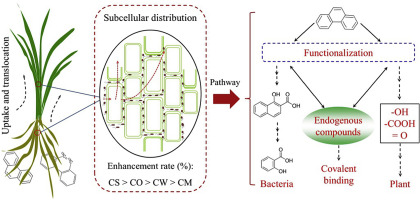Environmental Pollution ( IF 7.6 ) Pub Date : 2017-11-15 , DOI: 10.1016/j.envpol.2017.11.039 Kai Sun , Mussie Y. Habteselassie , Juan Liu , Shunyao Li , Yanzheng Gao

|
Contamination of food-crops with polycyclic aromatic hydrocarbons (PAHs) poses a grave concern to food safety, especially when PAHs are internalized. We have demonstrated in our previous study that inoculation of crop with a phenanthrene-degrading endophytic Pseudomonas sp. Ph6-gfp could overcome this problem. Here, the subcellular distribution and biotransformation mechanism of phenanthrene in pakchoi (Brassica chinensis L.) seedlings with inoculation of Ph6-gfp were further investigated both in vitro and in vivo. The possible biotransformation products of phenanthrene were identified by high-resolution mass spectrometry (HRMS) coupled with 13C2-phenanthrene labeling. Results indicated that Ph6-gfp colonized pakchoi interior and reduced the content of phenanthrene in different cell compartments. Notably, the inoculation hindered the subcellular distribution of phenanthrene from intercellular space to subcellular fractions (i.e., cell wall, cell membrane, cell solution, and cell organelles), likely resulting from the interception and biodegradation of phenanthrene by the bacterium between the cell wall and intercellular space. Additionally, the conjugation reactions of phenanthrene-metabolites and endogenous plant compounds were enhanced as a result of the inoculation. We propose that endophytic degradation, plant metabolism, and conjugation reaction are the three possible biotransformation mechanisms that could account for the changes in phenanthrene inside the plant cell compartments. This is the first observation of endophytic bacteria (EB)-enhanced biotransformation and conjugation of phenanthrene in pakchoi at the subcellular level, which drive novel insights in regulating food-crop contamination with endophytes in PAH-contaminated matrices.
中文翻译:

内生假单胞菌接种后小白菜中菲的亚细胞分布和生物转化。使用HRMS和同位素标记进行探测
多环芳烃污染了农作物,对食品安全构成了严重的关注,特别是当多环芳烃被内在化时。在先前的研究中,我们已经证明了使用菲降解的内生假单胞菌sp。接种农作物。Ph6- gfp可以解决此问题。这里,菲的小白菜(亚细胞分布和生物转化机制小白菜L.)与Ph6-的接种幼苗GFP两者进一步研究在体外和体内。通过高分辨率质谱(HRMS)和13 C鉴定了菲的可能的生物转化产物2-菲标记。结果表明,Ph6- gfp在小白菜内部定殖,并减少了不同细胞室中菲的含量。值得注意的是,接种阻碍了菲从细胞间空间到亚细胞部分的亚细胞分布(即(细胞壁,细胞膜,细胞溶液和细胞器),这可能是细菌在细胞壁和细胞间空间之间被菲氏菌拦截和生物降解所致。另外,接种后菲-代谢物与内源性植物化合物的结合反应增强。我们提出内生降解,植物代谢和结合反应是三种可能的生物转化机制,可以解释植物细胞室内菲的变化。这是首次观察到内生细菌(EB)增强了小细胞在亚细胞水平上小菜中菲的生物转化和结合的能力,这为在PAH污染的基质中用内生菌调节食物作物污染提供了新的见解。











































 京公网安备 11010802027423号
京公网安备 11010802027423号